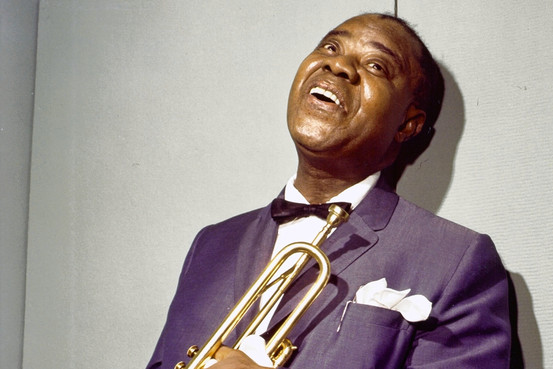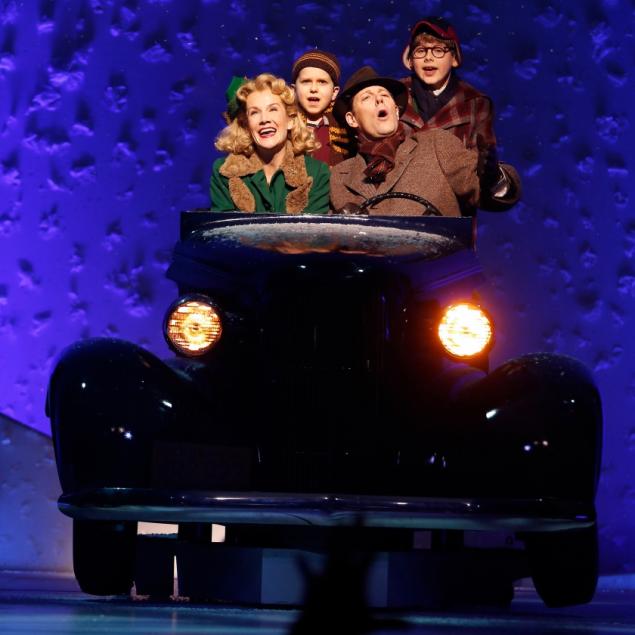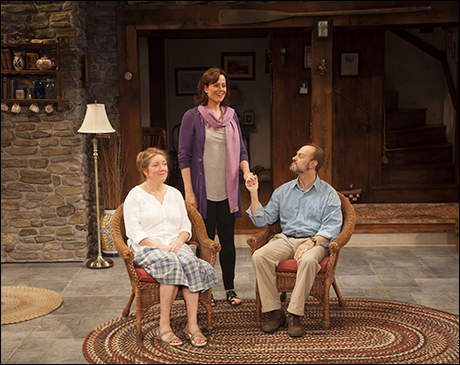“Most Americans take it for granted, as well they should, that in a democracy, the experience of going to an art museum should be made more widely accessible. But any museum that starts down the twisty road of cultural democratization can lose sight of its overarching mission…”
Archives for November 23, 2012
TT: One from the home team
 The Wall Street Journal, which usually stands mute when it comes to the extramural activities of its own contributors, decided to take note of Satchmo at the Waldorf today:
The Wall Street Journal, which usually stands mute when it comes to the extramural activities of its own contributors, decided to take note of Satchmo at the Waldorf today:
The reviews of Terry Teachout’s one-man play “Satchmo at the Waldorf” share two common elements. They start with some version of the following: “It takes a brave theater critic to write a play.” And then they quickly proceed to some version of “It’s a great show.”…
Read the whole thing here.
* * *
A Wall Street Journal-produced video about Satchmo at the Waldorf:
TT: Once more, with production numbers
In today’s Wall Street Journal I report favorably on two new shows, the musical version of A Christmas Story (surprise!) and Christopher Durang’s Vanya and Sonia and Masha and Spike. Here’s an excerpt.
* * *
 Recipe for a successful commodity musical: (1) Obtain the stage rights to a well-liked film. (2) Write a script that sticks close to the original plot, so as not to upset the public. (3) Add safe, uninteresting songs and fancy sets and costumes. (4) Sit back and count the money. This, of course, is also a sure-fire recipe for a dull show, which is why commodity musicals are a blight on Broadway. Once in a while, though, the odd thing happens. “A Christmas Story,” the stage version of Bob Clark’s charming 1983 film about Ralphie, a sweet little kid from Indiana who longs to find an Official Red Ryder Carbine-Action Two-Hundred-Shot Range Model Air Rifle under the tree on Christmas morning, ought by all rights to be tedious in the extreme–but it isn’t. Some of it, in fact, is really good, and none of it is less than watchable.
Recipe for a successful commodity musical: (1) Obtain the stage rights to a well-liked film. (2) Write a script that sticks close to the original plot, so as not to upset the public. (3) Add safe, uninteresting songs and fancy sets and costumes. (4) Sit back and count the money. This, of course, is also a sure-fire recipe for a dull show, which is why commodity musicals are a blight on Broadway. Once in a while, though, the odd thing happens. “A Christmas Story,” the stage version of Bob Clark’s charming 1983 film about Ralphie, a sweet little kid from Indiana who longs to find an Official Red Ryder Carbine-Action Two-Hundred-Shot Range Model Air Rifle under the tree on Christmas morning, ought by all rights to be tedious in the extreme–but it isn’t. Some of it, in fact, is really good, and none of it is less than watchable.
“A Christmas Story,” mind you, follows the recipe in every way. Nothing happens in the show that doesn’t happen in the film, all of the now-familiar plot twists are present and accounted for, the members of the cast endeavor mightily to suggest the well-remembered performances of their cinematic counterparts, and the reassuringly obvious song titles include “A Major Award,” “Red Ryder Carbine Action BB Gun” and “You’ll Shoot Your Eye Out!”
So what works? Quite a lot, actually, starting with the staging. John Rando is a scintillating musical-comedy director–his “Guys and Dolls,” mounted last year at Massachusetts’ Barrington Stage, was the best revival of that classic musical that I’ve ever seen–and he and Warren Carlyle, the choreographer, infuse “A Christmas Story” with plenty of liveliness and flair….
 Christopher Durang writes comedies with stiletto-sharp stings in the tail, some of which are devastatingly funny and others exasperatingly messy. “Vanya and Sonia and Masha and Spike” is one of the former, an inside-out medley of Chekhov’s Greatest Hits in which key moments from the Russian playwright’s oeuvre are scrambled into a camp cartoon about a melancholy Pennsylvania family whose members (Kristine Nielsen, David Hyde Pierce and Sigourney Weaver) were named by their theater-loving parents after characters from “Three Sisters” and “Uncle Vanya.” The trick up Mr. Durang’s sleeve is that the play’s onstage lunacy is the distorted outward manifestation of the deep-seated sorrows of its protagonists, especially Sonia (Ms. Nielsen), a sad sack who gets her biggest laughs simply by telling the awful truth about her unfulfilled life: “My relationships with men have been limited to ‘Here’s your change, ma’am’ at the supermarket.”
Christopher Durang writes comedies with stiletto-sharp stings in the tail, some of which are devastatingly funny and others exasperatingly messy. “Vanya and Sonia and Masha and Spike” is one of the former, an inside-out medley of Chekhov’s Greatest Hits in which key moments from the Russian playwright’s oeuvre are scrambled into a camp cartoon about a melancholy Pennsylvania family whose members (Kristine Nielsen, David Hyde Pierce and Sigourney Weaver) were named by their theater-loving parents after characters from “Three Sisters” and “Uncle Vanya.” The trick up Mr. Durang’s sleeve is that the play’s onstage lunacy is the distorted outward manifestation of the deep-seated sorrows of its protagonists, especially Sonia (Ms. Nielsen), a sad sack who gets her biggest laughs simply by telling the awful truth about her unfulfilled life: “My relationships with men have been limited to ‘Here’s your change, ma’am’ at the supermarket.”
Not only does Ms. Nielsen have the best part, but she gives the best performance of the evening, the high point of which is a phone-call monologue that is as smartly written as any of Mr. Durang’s glittering comic sketches….
* * *
Read the whole thing here.
A preview of the Lincoln Center Theater production of Vanya and Sonia and Masha and Spike:
TT: Kid stuff at the Clark
In today’s Wall Street Journal “Sightings” column I take a skeptical look at Giselle’s Remix, a museum exhibition “curated” by a child–and at its larger cultural implications. Here’s an excerpt.
* * *
Most Americans take it for granted, as well they should, that in a democracy, the experience of going to an art museum should be made more widely accessible. But any museum that starts down the twisty road of cultural democratization can lose sight of its overarching mission, which is to preserve and protect great works of art, make them accessible to the public and teach its visitors how best to look at them. This last involves deploying the institutional expertise of its curatorial staff in the service of defining what it means to call art “great.” Yet I’ve been to more than a few museums whose patrons were so busy dining in the café, listening to noontime concerts and shopping for knick-knacks that scarcely any of them bothered to look at the art on the walls.
How can established museums reach out to new viewers without compromising their time-honored function? One approach is now being tried out at the the Clark Art Institute of Williamstown, Mass., which has just launched a program called “uCurate.” Visitors to the Clark are invited to download a digital app that allows them to design imaginary art exhibitions made up of pieces in the museum’s permanent collection, then enter them in a competition whose winners get to install their shows in a gallery at the Clark with the help of the staff.
The Clark’s first uCurator is Giselle Ciulla, an 11-year-old girl who has put together a show called “Giselle’s Remix” which consists of 18 paintings, sculptures and objets d’art by Corot, Degas, Renoir, Winslow Homer, George Inness and other artists. She has also written the wall labels, of which this one, for Homer’s “Sleigh Ride,” is representative: “I like how the only thing is the sleigh, like nothing else is alive, just the horse and the rider.”
It’s easy to see what the Clark, an admirable but decidedly unsexy institution whose conservative collection consists in the main of 19th-century French paintings, is up to. “Giselle’s Remix”? “uCurate”? We’re talking young here. The program might as well be called “U 2 Can B a Curatr.”…
* * *
Read the whole thing here.
TT: Almanac
“On reflection, moral judgment in the arts appears rather as a tribute to their power to influence emotion and possibly conduct. And reflecting further on what some critics do today, one sees that a good many have merely shifted the ground of their moralism, transferring their impulse of righteousness to politics and social issues.”
Jacques Barzun, “What Critics Are Good For”
